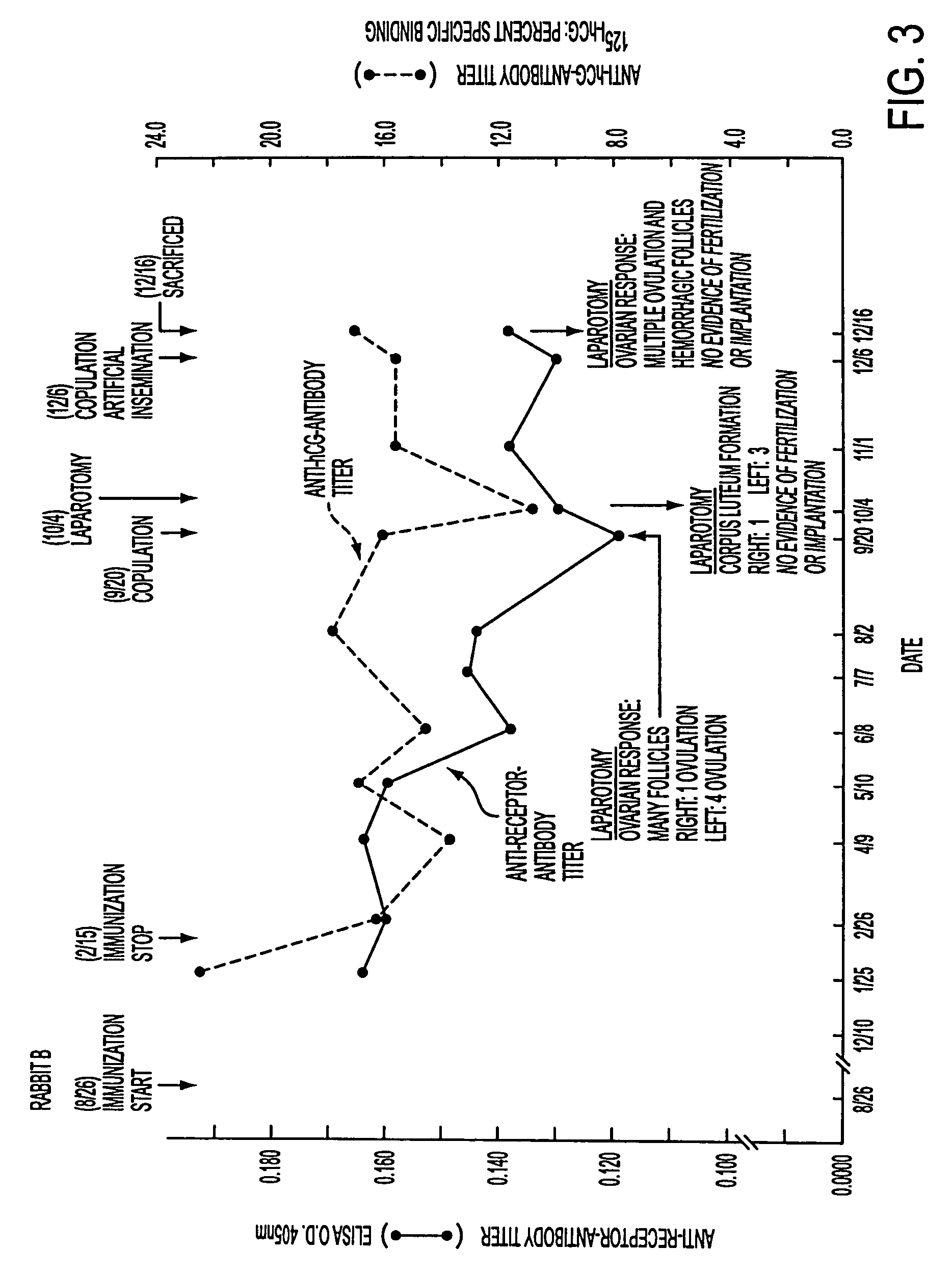hCG-hLH receptor and hCG-hLH receptor-hCG complex as antigens, antibodies thereto and contraceptive vaccine
- Summary
- Abstract
- Description
- Claims
- Application Information
AI Technical Summary
Benefits of technology
Problems solved by technology
Method used
Image
Examples
reference example 1
[0039] Receptor Purification
[0040] 1,200 bovine ovaries stored at −60° C. were thawed. The corpora lut a therefrom were homogenized for 15 to 20 seconds in 0.1 M Tris-HCl buffer (pH 7.4, containing 1 mM each of CaCl2, MgCl2 and dithiothr itol, 0.01% sodium azide, 10−6M phenymethylsulfonyl fluoride) and 100 μg / ml soy bean trypsin inhibitor containing 15% sucrose in a tissue to buffer ratio of 1:10 (w / v). The homogenate was centrifuged for 30 minutes in 8 one liter capacity swing-out buckets at 1,000 rpm (Sorvall, Newton, Conn.). The supernatant was recentrifuged at 7,000×g for 45 minutes. The yield was 100 grams of protein. The 7,000×g supernatant was concentrated 8-fold by an Amicon DC-10 unit equipped with Hl-50 hollow fiber cartridge (Amicon, Lexington, Mass.) suspended in an equal volume of the Tris-HCl buffer, reconcentrated to the original volume to reduce sucrose concentration and stored in 200 ml aliquots at −60° C. (All temperature values herein are centigrade unless stated...
reference example 2
[0074] Receptor Purification
[0075]FIG. 1 is a flow diagram of the most preferred receptor purification method of the present invention which is described in detail below.
[0076] A batch of 1200 g of fresh bovine ovaries stored at −60° C. were thawed. Corpora lutea (200 g) were dissected and homogenized with 1500 ml of 10 mM Tris-HCl buffer (pH 7.2, containing 20% glycerol, 1 mM MgCl2, 0.01% NaN3 and 10−6 M leupeptin). The homogenate was centrifuged at 164×g for 30 minutes to remove cell debris, and to recover more than 90% of protein hormone binding activity. Th supernatant was further centrifuged at 16,300×g at 4° C. for 2½ hours. Almost 30% of proteins with 80% of hormone-binding activity were sedimented, and 70% of proteins with 20% of hormone-binding activity was removed in the supernatant which was discarded. The LH-hCG receptor in the sediment was solubilized in 1,000 ml of 10 mM Tris-HCl buffer (pH 7.2, containing 1% Triton X-100, 1 mM MgCl2, 0.01% NaN3 and 10−6 M leupeptin)...
reference example 3
[0088] Formation of hCG-Receptor Unit
[0089] In this experiment, hCG-β and the electrophoretically homogeneous 5.9 million molecular weight receptor aggregate were utilized. hCG-β and the receptor were separately suspended in phosphate buffered saline at a concentration of approximately 1 milligram of protein per milliliter. DSS was dissolved in dimethyl sulfoxide at a concentration of 50 mM (1.8 mg DSS / 100 ml), the solution of DSS being added to a protein suspension containing 1.5 mg of hCG-β and 1.0 mg of the receptor so that the concentration of dimethylsulfoxide in the final solution is 2%. The mixture was incubated at 25° C. for 15 minutes. Any non-conjugated hCG was dissociated by dilution of the sample with an equal volume of 4 M MgCl2. Then, a second incubation was carried out at 4° C. for 10 minutes, followed by centrifugation at 5,000×g for 15 minutes.
[0090] The solution was subjected to Sepharose-6B chromatography using a column of 1×60 cm. The Sepharose-6B column was el...
PUM
 Login to View More
Login to View More Abstract
Description
Claims
Application Information
 Login to View More
Login to View More - R&D
- Intellectual Property
- Life Sciences
- Materials
- Tech Scout
- Unparalleled Data Quality
- Higher Quality Content
- 60% Fewer Hallucinations
Browse by: Latest US Patents, China's latest patents, Technical Efficacy Thesaurus, Application Domain, Technology Topic, Popular Technical Reports.
© 2025 PatSnap. All rights reserved.Legal|Privacy policy|Modern Slavery Act Transparency Statement|Sitemap|About US| Contact US: help@patsnap.com



